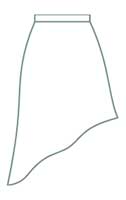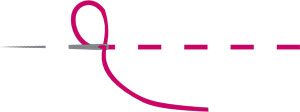Common Sewing Terms - A Reference For Everyone
Here's a list of sewing terms that I have come across most often in my sewing.
This will be a great reference tool as you learn more about sewing or simply want to refresh yourself on what particular sewing terms are all about.
Happy sewing!
A
Alteration:
This involves changing the size or style of a pattern for clothing or a home decor item.
Apparel:
This is just another term for clothing.
Appliqué:
This is a cut out fabric piece sewn onto another piece of fabric in a decorative way, either by machine or by hand.
Armscye:
This means "armhole” (the total length of the armhole's edge).
Asymmetrical:
Unbalanced or not equal (such as a hem on a skirt sloping from the front to the back)

Awl (Tailor's Awl):
This is a handy tool for making small holes in fabric. This is useful for putting in snaps, eyelets, and rivets. The awl separates the fibers of the fabric whereas simply punching a hole would break the fibers.

B
Backstitching:
This means securing the beginning and end of a machine stitched seam.

Ballpoint Needle:
A sewing machine needle with a rounded tip, designed for use with heavy knit fabrics, double knits, and synthetic-blend interlocks. These needles prevent runs in the fabric as the needle tip does not catch or cut the fabric's fibers. They come in different sizes to sew knits of different weights.

Bar Tack:
A series of stitches tightly sewn, used to reinforce points of stress on an item such as a zipper, a pocket needing extra reinforcement at stress points. An example of this stitching appears on the pocket of jeans, as a tightly sewn area of zigzag stitches.

Baste:
This sewing term means temporarily sewing fabric pieces together, either by machine or by hand, before sewing with a more permanent stitch.

Use loose stitches which you will be easily able to remove after finding the proper fit. It helps if you use a contrasting thread color that will be easy to see when it comes time to rip it out.
If you are basting by machine, use the longest machine stitch available on your machine.
Batting:
This is the middle layer of a quilt, placed between the top and bottom layers of fabric. Batting is made of wool, cotton (even organic cotton), or other soft material such as polyester.

Bias:
This sewing term refers to the diagonal line of the fabric which intersects the lengthwise and crosswise grains. Fabric cut on the bias is cut on a 45 degree angle and has more stretch than when cut on the straight grain.
Beeswax:
Simply run your thread through this handy wax. Your thread will become stronger and will resist knotting.

Bias Tape (Bias Binding):
These are strips of fabric cut on the bias. They are available in various widths and have prefolded edges. You can buy bias tape packaged and ready to use in stores.

You can also make your own custom bias tape to coordinate with your project. This is great for finishing edges, especially curves, as it easily takes the shape of a curve because of its stretchy nature.
It is available in several modes: single fold, double fold, and extra wide. There is also bias tape available especially for hems.
Bias Tape Maker:
You'll need this handy tool to make your own bias tape in any fabric you choose. It comes in a variety of sizes to make the tape width you desire.

Basically, you feed your homemade bias strips through one end of this tool and as you pull it out the other end it is folded and ready to be pressed. You'll find great directions included with this tool.
Sewing Terms
Return to Sewing Terminology Page Return To Top Of This Sewing Terms Page
Go To The CreativeSewingTips.com Home Page










